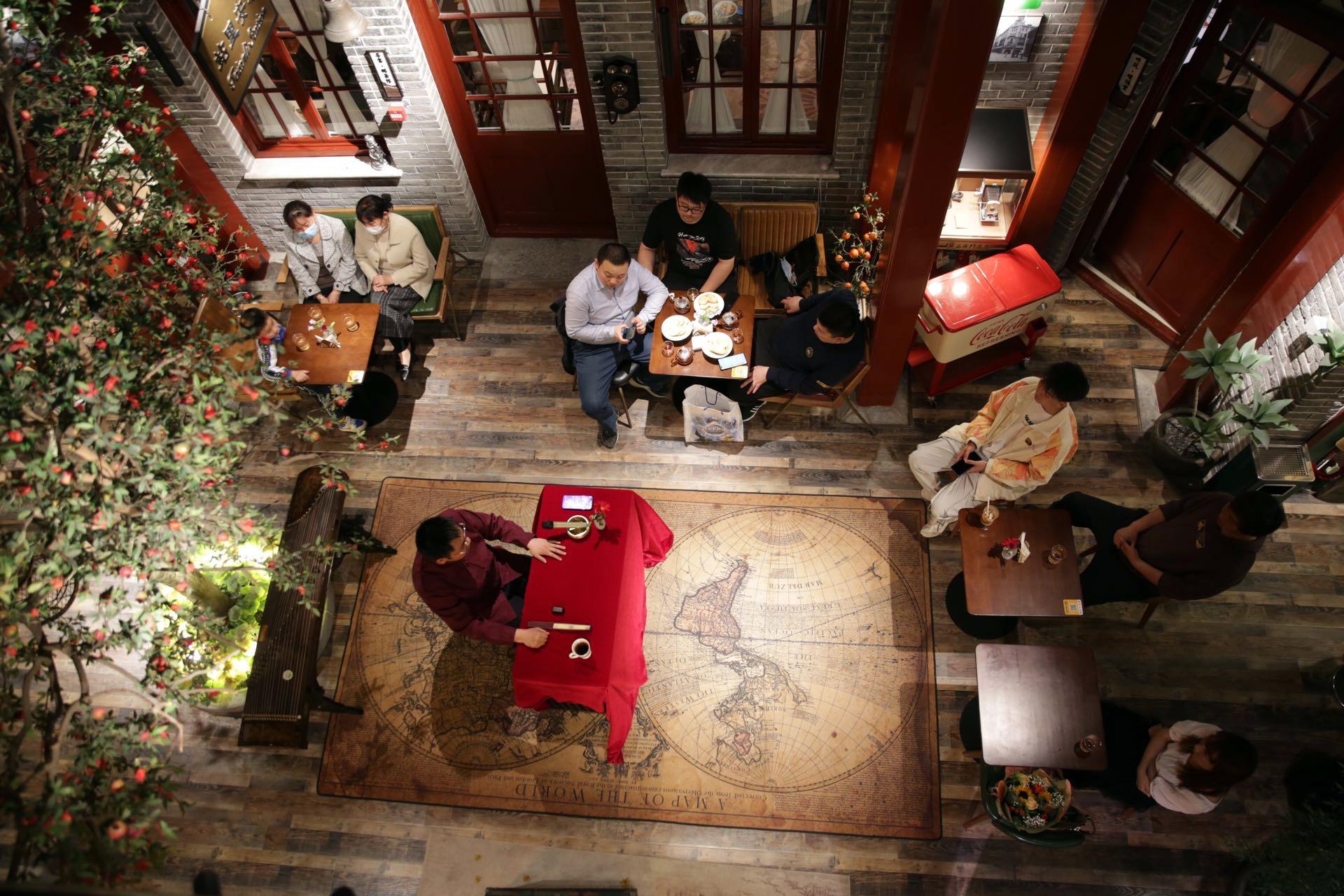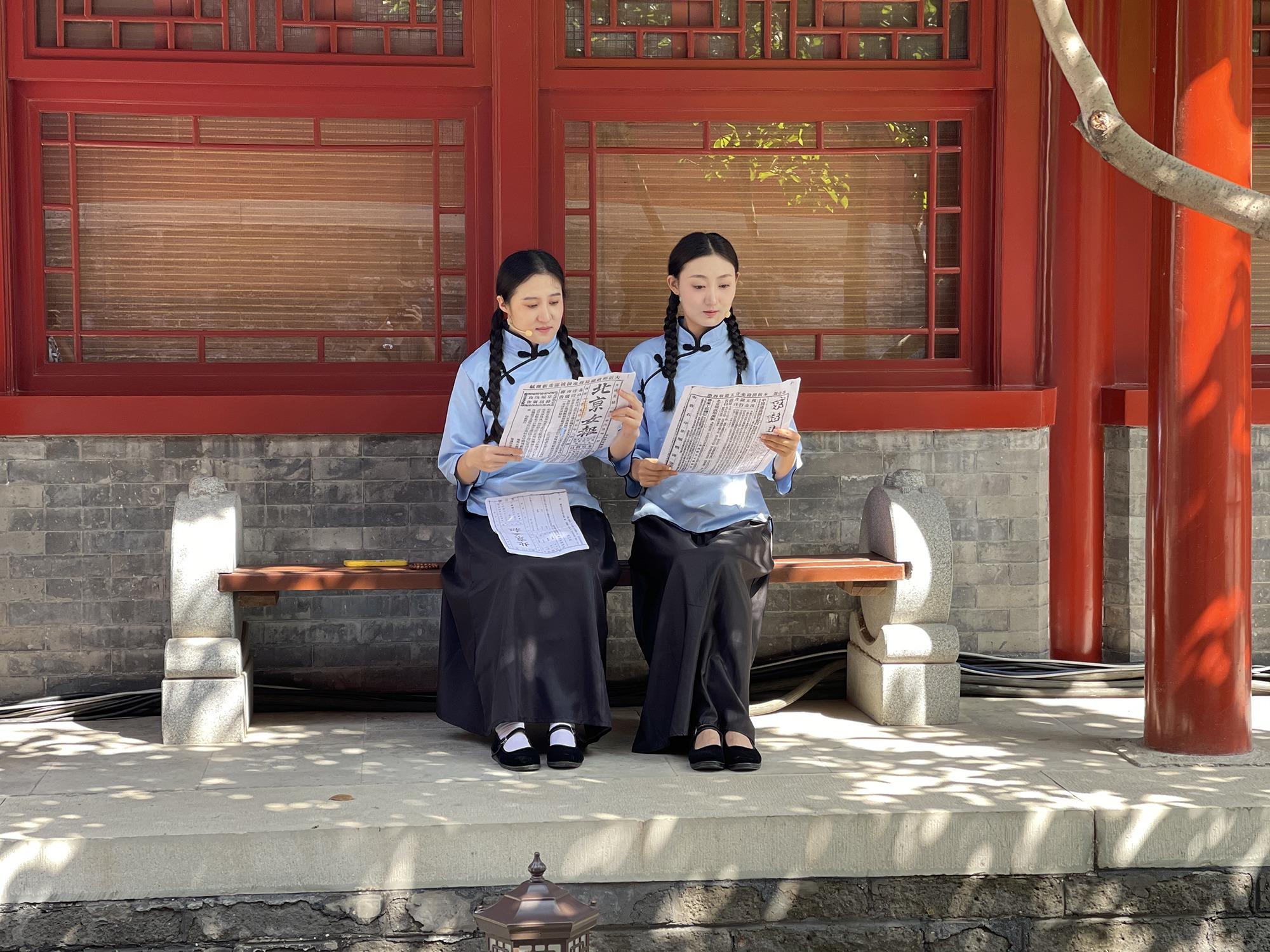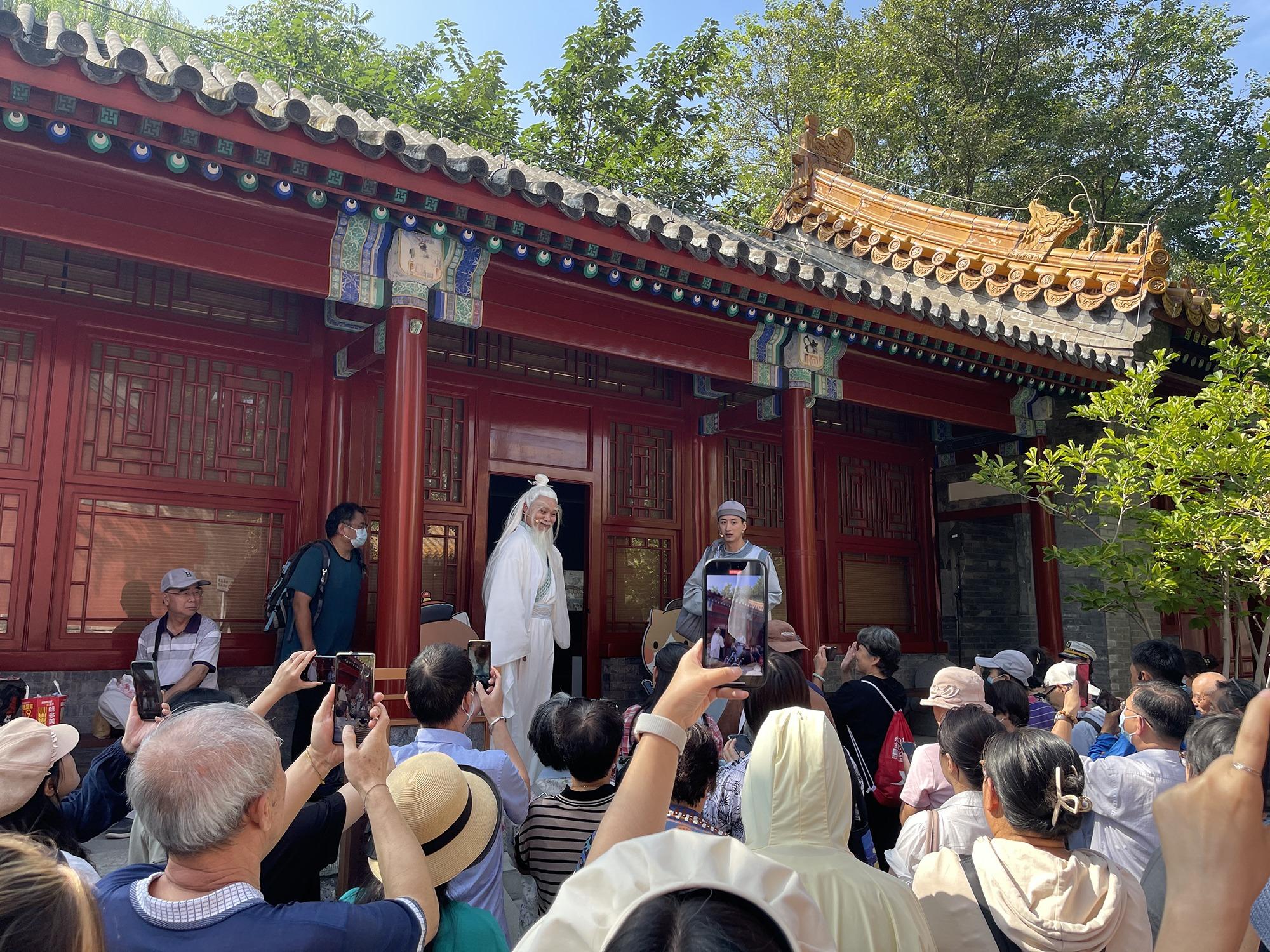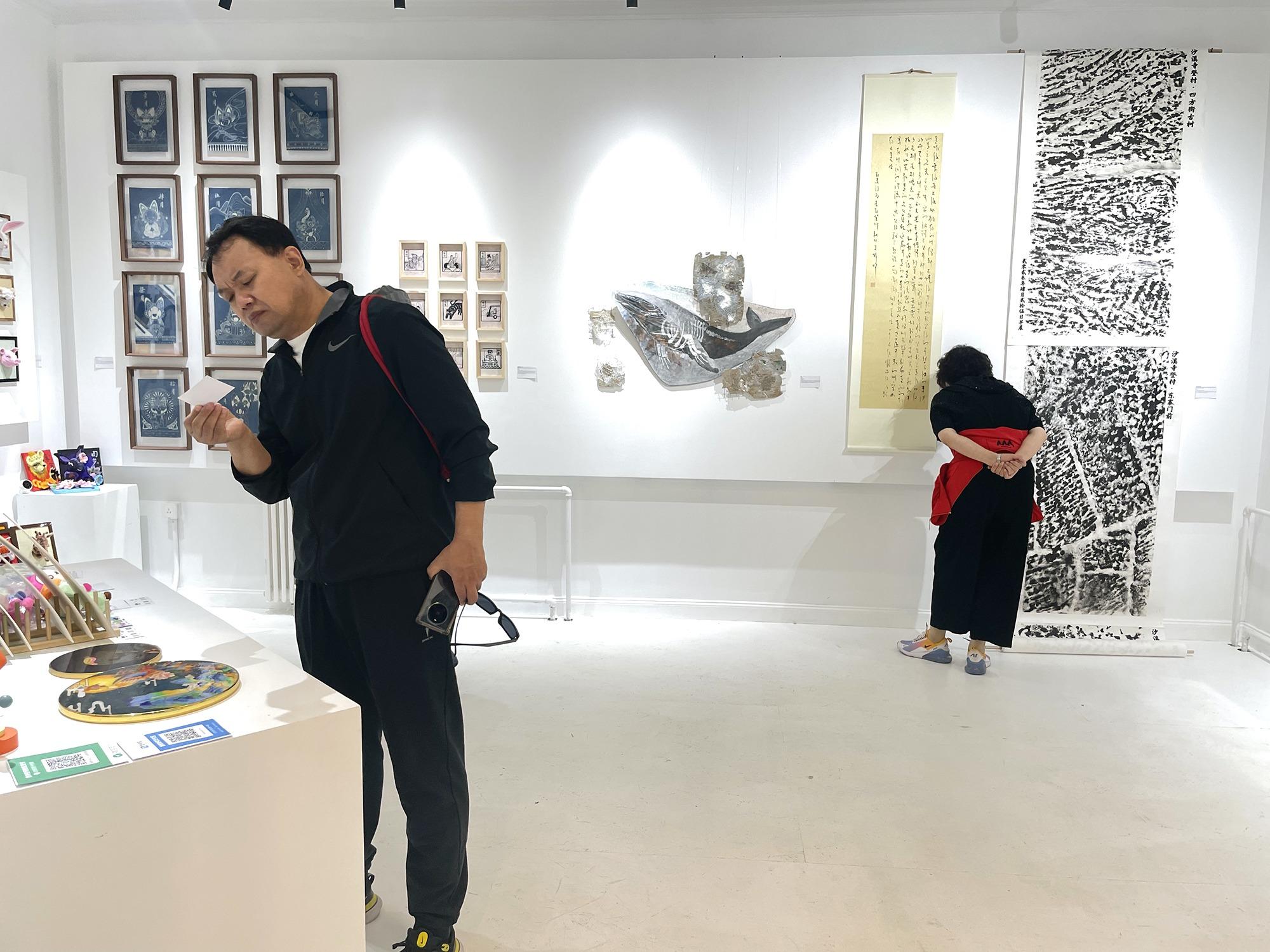Historical sites in downtown Beijing are finding innovative ways to attract the public, Yang Feiyue reports.
 Traditional Chinese storytelling is staged at the Shikumen Years teahouse in Tai'anli of Xicheng district, Beijing. (PHOTO PROVIDED TO CHINA DAILY)
Traditional Chinese storytelling is staged at the Shikumen Years teahouse in Tai'anli of Xicheng district, Beijing. (PHOTO PROVIDED TO CHINA DAILY)
Rustic wooden stairs and multicolored glass windows immediately set Tai'anli apart from the surrounding hutong. The cultural and arts center in the capital city's Xicheng district is tucked away inside a 70-meter-long alley that is paved with white cobblestones.
Green plants and gray gravel adorn the semi-open space that houses six small buildings, where exhibitions, a cafe, and a women's bookstore inject a sense of modernity.
Those actors communicate with the audience face-to-face, bringing historical culture to life.
Zhang Lina, curator of Beijing Xuannan Culture Museum
Tai'anli was originally a residential complex when it was first built in the 1910s, when the neighborhood area was the most fashionable place in Beijing, integrating shopping, dining, and entertainment, similar to the current CBD (central business district), says Hu Xuejing, an official in charge of the center's operations.
One of the iconic buildings in the area at that time, Tai'anli covers a not inconsiderable area of 3,120 square meters.
"Unlike Beijing's architecture, it imitated Shanghai's lane-style shikumen (stone gate) architecture, which was a combination of Chinese and Western architectural styles," Hu says.
The two-story shikumen buildings feature brick and wood structures with sloped roofs.
After the founding of the People's Republic of China in 1949, the building became a large miscellaneous courtyard, home to 89 households.
 Professional actors give the audience an immersive tour of the Xuannan culture at the Beijing Xuannan Culture Museum. (PHOTO PROVIDED TO CHINA DAILY)
Professional actors give the audience an immersive tour of the Xuannan culture at the Beijing Xuannan Culture Museum. (PHOTO PROVIDED TO CHINA DAILY)
The building was designated as a district-level cultural relic in 2009, and from then on, the Xicheng district government began the process of restoration.
"Originally, the space was very narrow, and was occupied by cubicles inside," Hu recalls.
"There were serious security risks, with local residents installing electrical wires at will. Not only that, they cooked here and the smoke stained the walls," she adds.
The restoration aimed to introduce a new layout on the basis of retaining the original structure, to cater to modern public life while generating good income.
"All renovations are reversible and do not damage the original structure of the building," Hu says.
"For example, they wrapped panels around the walls, when decorating the walls with spray paint," she explains.
The restoration project was completed in 2019.
"We repaired some of the decayed cultural components, including the bricks, house structures, doors and windows, and restored them to what they looked like 100 years ago, which is very beautiful," Hu says.
 Professional actors give the audience an immersive tour of the Xuannan culture at the Beijing Xuannan Culture Museum. (PHOTO PROVIDED TO CHINA DAILY)
Professional actors give the audience an immersive tour of the Xuannan culture at the Beijing Xuannan Culture Museum. (PHOTO PROVIDED TO CHINA DAILY)
In April, the center opened its doors to the public.
"When we first opened, we might see around 50 people per day, but now the number is up to 200," says Zeng Yaqi, who is in charge of running the Longtang Space, a cultural entity that runs an art exhibition area, a yoga studio, and a feminist-themed bookstore in Tai'anli.
More than 89,000 people have posted photos of their visit to the Longtang Space on leading social media platform Xiaohongshu, and 105,000 people discussed it on the popular consumer review platform Dazhong Dianping, Zeng says.
Night reading and exchange activities have been held at the bookstore and have attracted customers aged between 20 and 35, she adds.
"For residents and communities living nearby, Longtang Space will provide them with targeted services, such as intangible cultural heritage handicraft making and yoga courses," Zeng says.
She stresses that all the business activities have put cultural relic protection first and revolve around enriching public cultural life.
A stone's throw away, the Shikumen Years teahouse turns the clock back to old Shanghai, with its rich collection of antique objects, ranging from coffee spoons to printers and paintings from the past.
 Various themed exhibitions are held at Tai'anli to enhance visitor experience. (PHOTO PROVIDED TO CHINA DAILY)
Various themed exhibitions are held at Tai'anli to enhance visitor experience. (PHOTO PROVIDED TO CHINA DAILY)
The most distinctive examples include an old-fashioned camera and a telephone that uses coins from the Shanghai concession period, says Liu Bing, who runs the facility.
"We hope to decorate this historical cultural building to make it shine again, because the building itself is a kind of cultural relic," Liu says, adding that the idea is to have visitors experience the combination of Beijing and Shanghai cultures.
The teahouse was designed by the Beijing University of Civil Engineering and Architecture to make the best use of the building's original features.
"For example, the narrow space under the staircase is utilized and designed into a small corner similar to a shikumen, where a wine cabinet is placed," Liu explains.
"The mirror panel is attached to the roof, making the whole room, visually, seem taller. Designers also used their expertise of structural mechanics, which helped not only decorate the interior, but also protect the building's existing structure," Liu says.
Although the teahouse highlights tea culture, it also sells coffee to meet the demands of young customers.
Lunch is offered during the day, and a bar service begins when the night draws in. At the same time, the place has been used to host various cultural conferences and forums since it opened.
"We have been booked up during the holidays," she says.
 Folk music is among the highlights at the Shikumen Years teahouse. (PHOTO PROVIDED TO CHINA DAILY)
Folk music is among the highlights at the Shikumen Years teahouse. (PHOTO PROVIDED TO CHINA DAILY)
Some of the neighborhood's older residents like to come here during the day, and others usually flock in during the late afternoon and on weekends, she adds.
To date, Tai'anli has received more than 25,000 traveler visits and held in excess of 150 public cultural events, according to local administrators.
Tai'anli is part of Xicheng's efforts to revitalize its historical and cultural sites and equip them with new functions to enrich the cultural charm of Beijing.
More exhibitions, like those about the city's Central Axis, will be staged, according to the administration.
A 15-minute drive west from Tai'anli, Beijing Xuannan Culture Museum has packed in visitors since it introduced immersive plays featuring professional actors dressed in ancient costumes in May.
Xuannan refers to the area to the south of Xuanwu Gate and is considered one of the earliest Beijing cultural elements. As such, Xuannan culture can be regarded as one of the origins and an epitome of Beijing culture.
At the museum, visitors can travel through time and space with the actors and witness the life of Xuannan scholars during the late Qing Dynasty (1644-1911).
"Those actors communicate with the audience face-to-face, bringing historical culture to life," says Zhang Lina, the museum's curator.
Xuannan museum sits in Changchun Temple, which was built in the Ming Dynasty (1368-1644), and is a national key cultural relics protection unit.
After the founding of New China, Changchun Temple was used as a residential complex, with hundreds of families living there. In 2002, residents were relocated and a large-scale cultural relics restoration was carried out. In 2005, it was opened to the public as the Xuannan museum.
In 2019, a second renovation started, with the exhibitions at the museum getting upgraded at the same time.
After more than three years of renovation, Beijing Xuannan Culture Museum reopened to the public in May this year. The renovation included both the repair of the Changchun Temple, and the content and form of the exhibition, Zhang says.
The traditional museum experience, in which a narrator or guide speaks before the audience, can no longer meet the needs of many history and culture enthusiasts, so the museum came up with the immersive drama to walk the audience through its history.
A focus has been given to highlight the patriotism of the Qing Dynasty poets.
As for infrastructure, the doors and windows of the ancient buildings at the museum are brought to light, so visitors can directly see the structure of the Changchun Temple.
Moreover, the museum has introduced a lot of digital and multimedia equipment. "Each exhibition hall has at least one multimedia device that visitors can interact with," Zhang says.
"Combining modern digital multimedia technology, it presents different experiences to visitors," she adds.
So far, more than 25,000 people have paid visits to the museum since it reopened.
Speaking about the future, Zhang says that more learning experiences will be launched to satisfy the increasing cultural needs of the public.
As the immersive drama has proved very popular, more of them will be launched in the future.
"We will involve the audience in the performance and the creation process (of dramas), so that they can experience this history for themselves. This is one of the things we are going to explore next," Zhang says.
Yan Bingjie contributed to this story.
Contact the writer at yangfeiyue@chinadaily.com.cn



